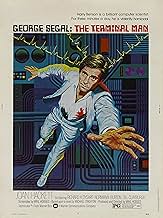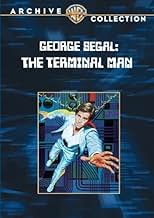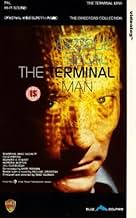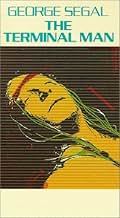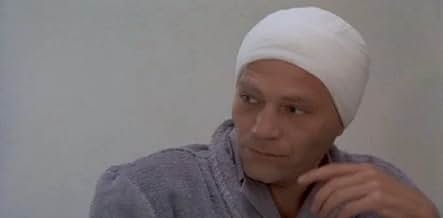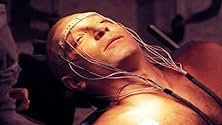Con la esperanza de curar sus ataques de desmayo, que le vuelven temporalmente extremadamente violento, un informático acepta someterse a una operación experimental de implante de un chip in... Leer todoCon la esperanza de curar sus ataques de desmayo, que le vuelven temporalmente extremadamente violento, un informático acepta someterse a una operación experimental de implante de un chip informático cerebral.Con la esperanza de curar sus ataques de desmayo, que le vuelven temporalmente extremadamente violento, un informático acepta someterse a una operación experimental de implante de un chip informático cerebral.
- Dirección
- Guionistas
- Elenco
- Dr. John Ellis
- (as Richard A. Dysart)
- Det. Capt. Anders
- (as Normann Burton)
- Dirección
- Guionistas
- Todo el elenco y el equipo
- Producción, taquilla y más en IMDbPro
Opiniones destacadas
This is a Michael Crichton book. The prolific writer has some big ideas but it often takes a good adaptation to inject a compelling narrative. This movie doesn't have it. The story is drawn-out and slow-moving. The surgery takes forever and generates little tension. The second half tries to turn into something else. By then, most people would have already lost interest. This movie may work better if it skips a lot of the surgery minutia. The story may have some social commentary to make but it's just too darn slow.
The likable George Segal stars as Harry Benson, a computer scientist who, since a car accident, has suffered from blackouts & seizures that made him dangerously violent. Now a team of surgeons is performing ground breaking surgery on him: attaching electrodes to 40 of his brain terminals that will hopefully counteract his violent impulses. However, as the viewer certainly suspects will happen, this doesn't work, and his brain ends up craving the shocks / stimuli that it receives, and Harry loses control once again.
I can certainly understand the problems that some people may have with this production, as it's really not the typical thriller at all. It's slow, and it's quiet; there's not even that much musical accompaniment on the soundtrack. It does exhibit a fairly cold, clinical approach, and the emphasis on the story's exposition will inevitably bore people more conditioned to non- stop action in what they watch. Even after Harry has made the expected escape from the hospital, he doesn't spend that much time running amok, and certainly does not kill very many people.
But this movie *is* noticeably intelligent and thoughtful and does offer rewards for patient viewers. It has one striking murder set piece that's rather artfully done; it takes place atop a water bed, and the sprays of water and the way the blood spreads definitely are what make the scene. And, like other movies of this kind, there is a certain wariness (voiced by Harry) on the part of mankind regarding the computer age and what it could mean for us all.
Another wonderful element to "The Terminal Man" is its incredible cast of both stars and rock solid character actors. Segal is effectively low key in the lead, and is nicely supported by Joan Hackett, Jill Clayburgh (in a small but welcome appearance), Richard Dysart, Donald Moffat, Matt Clark, Michael C. Gwynne, William Hansen, and Norman Burton. (It's particularly fun to see Dysart and Moffat sharing scenes eight years before they did John Carpenters' "The Thing" together.) And playing smaller roles are the likes of James B. Sikking, Steve Kanaly, Jack Colvin, Ian Wolfe, Lee de Broux, Victor Argo, and Nicholas Worth.
This is all reasonably engaging stuff, leading up to an ending that, while somewhat conventional, is staged in a very unique way. All in all, "The Terminal Man" is a good movie that does deserve to be discovered or rediscovered.
Seven out of 10.
That's one thing you need to know going in. The other is not that it's slow, but that it spends a ridiculous amount of time on the fictitious surgery. For example, the doctor almost hits a vein in the patient's brain which would have killed him. However, a surgical mistake can happen in any sort of surgery and this lengthy bit doesn't address the far more interesting ethical issues.
This is in contrast to The Andromeda Strain. In that film, there are enormously detailed and lengthy scenes of the Wildfire lab. But the difference is that movie was more about the scientists and the lab than the germ itself. Here, that's just not the case.
There's other parts of the film that provide a weird atmosphere yet seem entirely irrelevant. The doctor goes to a strip club to find Segal and while I like the music played, it's hard to see why this is here considering it's mostly focused on the stripper stage.
The far more interesting issues are of course the ethical ones.
The treatment they give this man is directly compared to lobotomies, a very dark page of medical history. After they install the device, they start activating different electrodes to see what happens... this isn't that much different than the lobotomy performed on Rosemary Kennedy where they kept cutting while talking to her to see the effects. It's incredibly chilling and plausible.
A curiosity here is that there is essentially an ad for Scientology on the radio in the background in one scene. This makes sense considering their disdain for psychiatry which was rather well founded at least at the time.
There's frustration here in that one huge theme seems to have been all but ignored-- that the patient was convinced computers would take over. I suppose the idea might have been that Segal was increasingly acting robotic... in several scenes when he's walking he does seem like a mindless drone. But I just saw him as a zonked out zombie and zombies are standard horror fare. It didn't occur to me that that might have been the idea until I was writing this review.
Anyway, it's a fascinating watch as long as you know what you're getting into. It's definitely NOT a thriller. There are many striking visuals, like a long curious zoom on a parrot.
His wife leaves him, and it looks like his outbursts will have him traveling through the criminal justice system which can do nothing for this situation or maybe he will wind up shot dead by some would be victim.
So some scientists think that Benson could be a beneficiary of an experimental procedure in which a small computer is implanted in his brain and his epilepsy is controlled by impulses the computer transmits. Post operation, things seem to be a success, but Dr. Janet Ross (Joan Hackett) discovers that Benson's brain is becoming addicted to the impulses, and in time - and she actually can calculate the time - he will have more frequent and severe violent outbursts.
But before she can do any kind of medical intervention, Benson leaves. Apparently he has prearranged an escape with some woman he barely knows, sporting a blond wig so you can't tell he just had surgery.
So the last half of the film is just Benson having those predicted seizures and becoming horrifically violent during each one. It doesn't have the pathos or irony of the Frankenstein monster's trek through the German countryside. Segal just begins to shake, his eyes roll up in his head, and he does violence to whomever and with whatever is at hand. That's it. That's essentially all that the last half is.
George Segal never really got the credit he deserved for some of the really good roles he had in the 70s. This is not one of those good roles, and I really don't see how he or anybody else but the writer could have saved a film that is really only half there. I'd give the pre-escape part of the film a 7 or 8. I'd give the last half a three. This is where I come up with my 5/10 rating.
¿Sabías que…?
- TriviaCrichton was fired from writing the screenplay due to the fact that his script did not follow the novel (which he had written) closely enough.
- ErroresAt the cemetery, the usual mechanism for lowering the coffin into the grave is missing. There aren't even any straps in place to lower it manually.
- Citas
Benson: [mumbles]
Dr. John Ellis: [operating on Benson] What was that?
Dr. Robert Morris: Patient.
Dr. John Ellis: You all right, Mr. Benson?
Benson: [groggily] Fine... fine...
Dr. John Ellis: Any pain?
Benson: No...
Dr. John Ellis: Good. Just relax now.
Benson: You too doctor...
- Versiones alternativasOn its release at 2003 Edinburgh Film Festival, there was a director's cut which Hodges had cut out the beginning with the doctor looking at photographs of Harry Benson.
- ConexionesFeatured in Cinemacabre TV Trailers (1993)
- Bandas sonorasGoldberg Variation No. 25
by Johann Sebastian Bach (as J.S. Bach)
Played by Glenn Gould
Courtesy Columbia Records
Selecciones populares
- How long is The Terminal Man?Con tecnología de Alexa
Detalles
- Fecha de lanzamiento
- País de origen
- Idioma
- También se conoce como
- The Terminal Man
- Locaciones de filmación
- Productora
- Ver más créditos de la compañía en IMDbPro
Taquilla
- Total en EE. UU. y Canadá
- USD 224,542
- Tiempo de ejecución1 hora 44 minutos
- Mezcla de sonido
- Relación de aspecto
- 1.85 : 1
Contribuir a esta página



